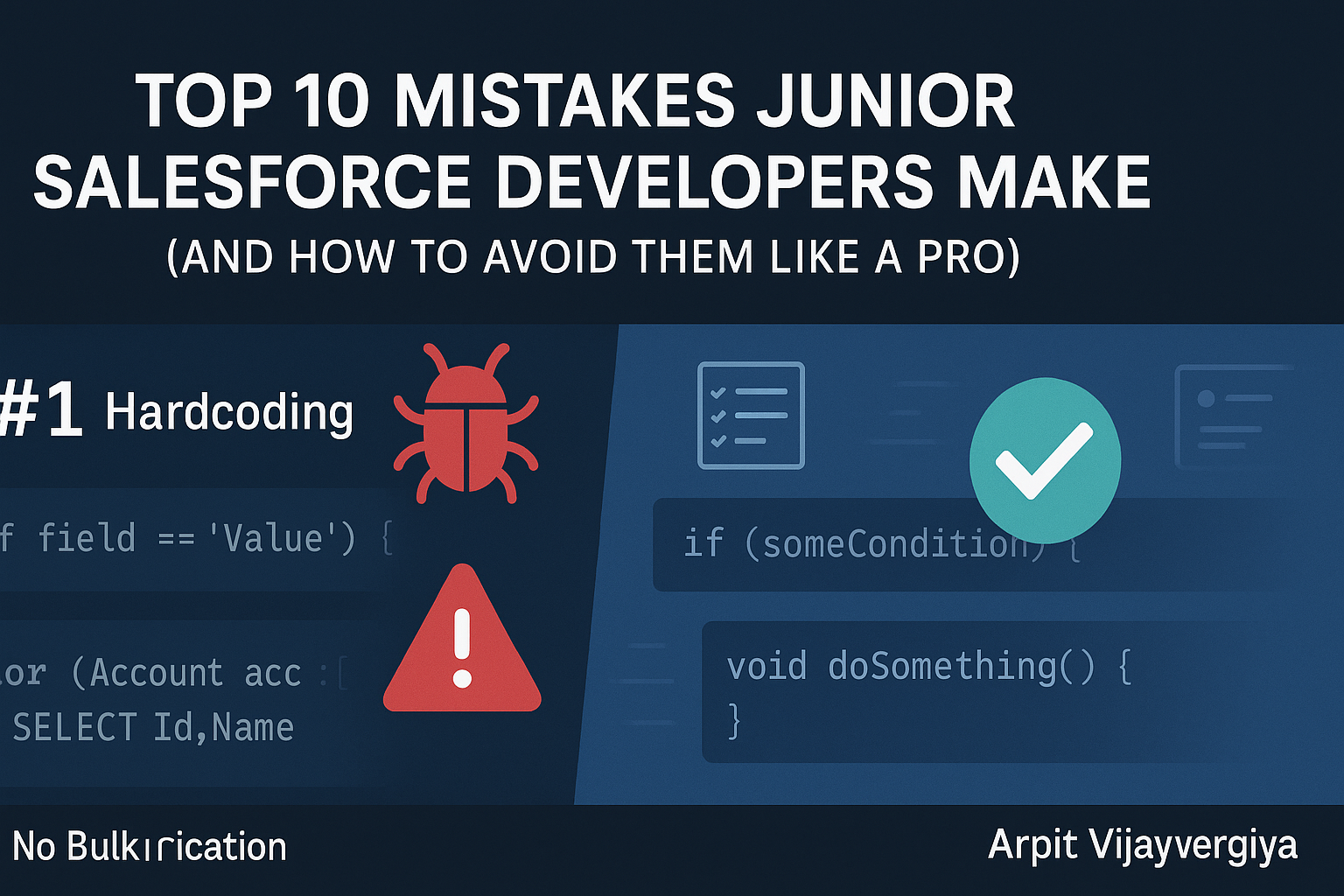Top 10 Mistakes Junior Salesforce Developers Make
Entering the Salesforce developer world feels like unlocking a superpower — until your first trigger explodes in UAT and your admin messages you: “Hey, all the Contacts just vanished. Did you do something?” 🫠
Don’t worry. We’ve all been there — mistaking governor limits for friendly suggestions, and using “SeeAllData=true” like a magical fix.
Here are the 10 most common mistakes junior Salesforce developers make, with real advice, real solutions. 👇
Hardcoding RecordType IDs like it’s 2015
❌ What You Write:
if(record.RecordTypeId == '0128x000000XYZ') {
// logic
}
🚨 Why It’s a Problem:
Sandbox breaks. Production laughs. Metadata cries. And you end up debugging at 11:57 PM before a release.
✅ The Fix:
Id recTypeId = Schema.SObjectType.Contact.getRecordTypeInfosByName().get('Customer').getRecordTypeId();
Pro Tip: If you’ve got 6 hardcoded IDs in one class… you're not writing code, you're building a legacy. 🧓
Querying Inside a Loop — aka “How to Summon the SOQL Limit Demon”
❌ Rookie Move:
for(Contact c : conList){
Account a = [SELECT Name FROM Account WHERE Id = :c.AccountId];
}
💥 Boom:
You hit 101 SOQL queries, and Salesforce politely throws you out of the execution context.
✅ Instead:
Query first. Loop second. Be kind to your limits.
Map<Id, Account> accMap = new Map<Id, Account>([SELECT Name FROM Account WHERE Id IN :accIds]);Putting All Your Logic Inside a Trigger Because “It Works, Right?”
❌ Rookie Code:
apexCopyEdittrigger OpportunityTrigger on Opportunity (before insert) {
for(Opportunity o : Trigger.new){
o.StageName = 'Prospecting';
}
}
🧟♂️ What Happens:
Your trigger becomes a zombie — slow, ugly, and terrifying in production.
✅ Instead:
Use a Trigger Handler Framework. Keep triggers skinny. Logic belongs in Apex classes, not in the trigger buffet.
Using @isTest(SeeAllData=true): The Nuclear Option
❌ Oh No You Didn’t:
@isTest(SeeAllData=true)
😵 Why It’s Dangerous:
You’re basically telling Salesforce, “Trust me, bro.”
✅ What to Do:
Write your own test data. Use @testSetup. Your future self (and your QA team) will thank you.
Writing Only Happy Path Test Cases Like It’s a Rom-Com
❌ The Mistake:
insert new Account(Name = 'Happy Corp');
📉 The Result:
Coverage? ✅
Quality? ❌
Reality? LOL.
✅ The Fix:
- Bulk test with 200 records
- Include negative scenarios
- Use
System.assertEquals()like a grown-up
Forgetting About Governor Limits — Until They Punch You in the Logs
❌ What You Ignore:
- SOQL Queries
- CPU Time
- DML statements
💣 What Happens:
Your code fails randomly. Like a moody teenager.
✅ The Fix:
Use Limits.getDMLStatements() and log it. Be mindful. Your org isn't unlimited. (Unless you’re working at Salesforce, then… maybe.)
Reinventing the Wheel Because StackOverflow Felt Too Easy
❌ What You Do:
Write custom code for:
- Pagination
- Retry logic
- Logging framework
🧙 The Truth:
Salesforce already has solutions for most of these. Don’t be a wizard. Be efficient.
✅ Use:
- Standard List Controllers
- Custom Metadata
- Queueable Apex
Using Apex for Everything — Even When Flows Are Better
❌ Example:
Update a field? Write a whole Apex class. 💪
😬 The Reality:
You just wrote 30 lines for what could’ve been 3 clicks.
✅ The Fix:
Use Flows, Validation Rules, and Workflow Rules (RIP). Save Apex for logic that actually needs it.
Copy-Pasting from Forums/GPTs Without Knowing What It Does
❌ You Think:
“This code has 17 upvotes, it must be good.”
“GPTs has given this piece of code”
😐 The Truth:
You just added 3 hidden bugs and a recursive call.
✅ Instead:
Understand every line. Test locally. And if it works, document why it works.
Top 10 Mistakes Junior Salesforce Developers Make
Apex best practices 2025
Salesforce developer checklist
